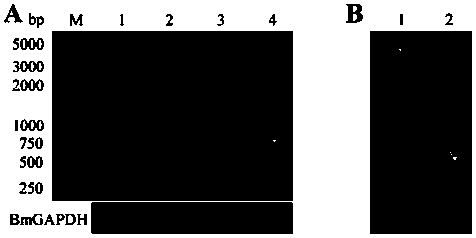Target sequence suitable for transgene fixed point insertion of silkworm W-chromosome and locus and application thereof
A chromosome and transgene technology, applied in the field of nucleotide sequences, can solve the problems of W chromosome sequence difficulties, etc., and achieve the effects of ensuring hybridization rate, improving comprehensive income, and clear fluorescent markers
- Summary
- Abstract
- Description
- Claims
- Application Information
AI Technical Summary
Problems solved by technology
Method used
Image
Examples
Embodiment 1
[0023] Embodiment 1, transgenic microinjection and screening of female-specific transgenic silkworm W-T
[0024] Silkworm eggs of silkworm "Dazao" and "P50" were soaked in acid for 5 minutes at a temperature of 46°C to remove diapause. The greening is accelerated in the environment for about 30 days until hatching. After hatching, the ant silkworms are collected and raised under standard conditions with a temperature of 25°C and a humidity of 80%. Silkworm eggs were non-diapause silkworm eggs, which were used for microinjection in the next step.
[0025] Arrange the laid silkworm eggs neatly on a clean glass slide, and inject the piggyBac [3×p3 EGFP afm] transgene vector and the auxiliary plasmid A3H into 5300 silkworm eggs with an Eppendorf microinjector 2 hours after the silkworm eggs were laid In the process, after sealing with non-toxic glue, put it in an environment of 25°C and 80% relative humidity to accelerate the greening for about 10 days. The hatched G0 generation ...
Embodiment 2
[0027] Example 2, copy number detection of transgenic system W-T
[0028] Primers were designed for the GFP mutant line EGFP and the silkworm internal reference gene GAPDH (BmGAPDH). The forward primer of EGFP was 5'-gtgagcaagggcgaggagct-3' (SEQ ID NO.1), and the reverse primer was 5'-cttgtacagctcgtccatgcc-3' (SEQ ID NO.2); the forward primer of BmGAPDH is 5'-cattccgcgtccctgttgctaat-3' (SEQ ID NO.3), and the reverse primer is 5'-gctgcctccttgaccttttgc-3' (SEQ ID NO.4). The genomes of W-T female silkworm (W-T♀), W-T male silkworm (W-T♂), non-transgenic female silkworm (NT♀) and non-transgenic male silkworm (NT♂) were extracted and used as templates for PCR amplification. The PCR reaction conditions for amplifying the BmGAPDH gene are: 94°C pre-denaturation for 4 minutes, followed by 94°C denaturation for 40 seconds, 58°C annealing for 40 seconds, 72°C extension for 10 seconds, a total of 25 cycles, and finally 72°C extension for 10 minutes; The PCR reaction conditions of EGFP w...
Embodiment 3
[0030] Example 3 Insertion site detection of transgenic system W-T
[0031] The genome of W-T♀ was thoroughly digested with Hae III and self-ligated, and then amplified by inverse PCR using transposon-specific primers pBacL and pBacR. pBacR is used to amplify the partial sequence of the right arm (PR) of piggyBac[3×p3EGFP afm] and the adjacent genomic sequence (SG-R). The pBacR primer sequence is as follows, pBacR F; NO.5); pBacR R: 5'-gtactgtcatctgatgtaccagg-3' (SEQ ID NO.6), pBacL was used to amplify the partial sequence of the left arm (PL) of piggyBac[3×p3EGFP afm] and the adjacent genome sequence (SG -L), the pBacL primer sequence is as follows, pBacL F: 5'-atcagtgacacttaccgcattgaca-3' (SEQ ID NO.7), pBacL R: 5'-tgacgagcttgttggtgaggattct-3' (SEQ ID NO.8), the position is as follows image 3 As shown in A. The PCR product was identified and recovered by agarose gel electrophoresis, and then ligated with pMD19-T vector. The ligation reaction was performed under the action...
PUM
 Login to View More
Login to View More Abstract
Description
Claims
Application Information
 Login to View More
Login to View More - R&D
- Intellectual Property
- Life Sciences
- Materials
- Tech Scout
- Unparalleled Data Quality
- Higher Quality Content
- 60% Fewer Hallucinations
Browse by: Latest US Patents, China's latest patents, Technical Efficacy Thesaurus, Application Domain, Technology Topic, Popular Technical Reports.
© 2025 PatSnap. All rights reserved.Legal|Privacy policy|Modern Slavery Act Transparency Statement|Sitemap|About US| Contact US: help@patsnap.com



